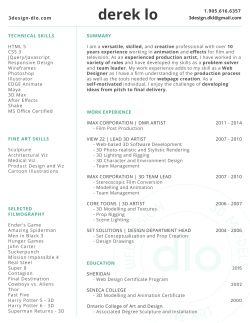
! DEMOREEL BREAKDOWN 1. Delta Mush Deformer
W E I WA N G D EMO RE EL B RE A K D O W N ! ! ! 1. Delta Mush Deformer C++, Maya API This project implements the smoothing method that was presented at SIGGRAPH 2014 by Rhythm & Hues Studios [1]. The deformer smooths arbitrary deformation of a polygonal mesh without smoothing the original detail of the model. This tool can be used for rapid rig development as well as cleaning up bad deformations. This deformer is written in C++ and parallelized using TBB. ! 2. Raytracer C++, Python features: KD-tree acceleration, multi-threading, recursive raytracing, area lighting, occlusion, texture/ bump mapping, Maya integration This ray tracer was implemented entirely from scratch in C++. It can render scenes built with geometric primitives as well as OBJ meshes. A KD-tree structure was implemented for fast ray-polygon intersection tests. The raytracing function was parallelized using pThread. The tracer also has a Maya plugin which enables sending a Maya scene to render. Responsible for everything. ! 3. Physically Based Simulation C++, OpenGL Fluid Simulation This program simulates fluid motion using the Smoothed-particle hydrodynamics (SPH) model presented by Matthias Müller, David Charypar and Markus Gross [2]. The simulation runs at 24 FPS or above for models consisting of up to 5500 particles. Cloth Simulation This cloth simulator is based on the mass-spring system. Both Euler and RK4 numerical integration schemes were implemented. It ha support for particle-spring forces, wind force, and interactive collision response with primitives. Particle System The monkey head continuously generates particles (total particle number around 40K) that interact with the environment. The particles are affected by adjustable gravity and wind force. The look and behavior of the particles are also controllable. A KD-tree structure is used for efficient particle-mesh inclusion tests. The simulation can Page 1 run in real-time with a dense mesh loaded as a collider. ! 4. Dark Light Maya, RenderMan, Houdini, Python The project: This 30-second animation was produced in 10 weeks in collaboration with Rachel Cunningham, Brian Smith, Caleb Jackson and Cassie Hanks under the direction of CG professionals from DreamWorks Animation. I was the rigging and effects lead on the team. The rig: The rig features FK dynamic antennas, procedural wing animation, dynamic parenting and breakable hierarchy. The rig also provides a GUI for facial animation. Responsible for the body rig and the facial GUI. Cooperated with Rachel Cunningham and Brian Smith on facial blendShapes. The FX: Responsible for the fire and the confetti effects. The fire effects were made using fluid simulations in Maya. They were rendered with RenderMan and then composited in Houdini. The confetti effect was made using cloth simulations in Maya. ! 5. Modular Rigging Tool (WIP) Python, Maya API The tool allows the user to interactively assemble a character rig using pre-defined modules and templates. The goal of the tool is to exempt the artist from the tedious rigging process and to create rigs with fully functioning controls in a short time. [1] Joe Mancewicz, Matt L. Derksen, Hans Rijpkema, and Cyrus A. Wilson. 2014. Delta Mush: smoothing deformations while preserving detail. In Proceedings of the Fourth Symposium on Digital Production (DigiPro '14). ACM, New York, NY, USA, 7-11. DOI=10.1145/2633374.2633376 http:// doi.acm.org/10.1145/2633374.2633376 [2] Matthias Müller, David Charypar, and Markus Gross. 2003. Particle-based fluid simulation for interactive applications. In Proceedings of the 2003 ACM SIGGRAPH/Eurographics symposium on Computer animation (SCA '03). Eurographics Association, Aire-la-Ville, Switzerland, Switzerland, 154-159. Page 2
© Copyright 2025





















